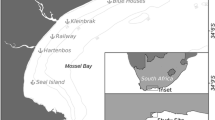Synopsis
This paper analyses the distribution of longline catches of swordfish, **phias gladius, and six species of pelagic elasmobranchs, during a fishing voyage in the tropical eastern Atlantic. Seven scales of sampling units, ranging from about 0.72 to 7.2 km were used. Observed frequencies of appearance of each species in the basic sampling unit, were compared with theoretical frequencies obtained from the Poisson and negative binomial distributions. For the study of the interspecific relationships, contingency tables were used and the degree of association was estimated using the χ2test and the coefficient v of Kendall. The catch distribution of the swordfish and the devil ray (Mobula sp.) can be explained by both randomness and a slight trend to association. For the pelagic sharks, a clear trend towards intraspecific clustering was found. Catches of two species of the genus Carcharhinus showed the most positive trends to interspecific association, especially in short ranges, probably due to attraction to previously hooked fish. The possible causes of these distributions are discussed.
Similar content being viewed by others
References cited
Au, D.W.K. 1984. Species composition in the Japanese longline fishery off the southern and eastern United States. Report to the Int. Comm. Conserv. Atlantic Tunas, Coll. Sci. Doc. 23 pp.
Bannister, K. 1989. The book of the shark. Quintet Publishing, London.
Fujii, I. & H. Okamoto. 1971. On the shapes of tuna longline gear under water and catches of tunas and billfishes. Showa 44 nendo Mie-ken Hamajima Suishi Jigyo Hokoku: 45–103.
129 pp Carey, F.G. & B.H. Robison. 1981. Daily pattern in the activities of swordfish, **phias gladius, observed by acoustic telemetry. U.S. Fish Bull 79: 277–292 Gruber, S.H. & L.J.V. Compagno. 1981. Taxonomic status and biology of the bigeye thresher, Alopias superciliosus. U.S. Fish. Bull. 79: 617–640.
Hanamoto, E. 1974. Fishery oceanography of bigeye tuna-I. Depth of capture by tuna longline gear in the eastern tropical Pacific Ocean. Lammer (Bull. Soc. franco-japon. Oceanogr.) 12: 10–18.
Klimley, A.P. 1987. The determinants of sexual segregation in the scalloped hammerhead shark Sphyrna lewini. Env. Biol. Fish. 18: 27–40.
Margalef, R., 1974. Ecologiá. Omega, Barcelona.
951 pp Muñoz-Chápuli, R. 1984. Ethologie de la reproduction chez quelques requins de I'Atlantique nord-est. Cybium 8 (3): 1–14.
Myrberg A. 1987. Shark behaviour. pp. 84–95. In: J.D. Stevens (ed.) Sharks, Merehurst, London.
Poole, R.W., 1974. An introduction to quantitative ecology. McGraw Hill, New York.
532 pp Springer S. 1963. Large sharks of the Florida-Caribbean region. pp. 95–113. In: P.W. Gilbert (ed.) Sharks and Survival, D.C. Heath Co., Boston.
Springer S. 1967. Social organization of shark populations. pp. 149–174. In: P.W. Gilbert, R.F. Mathewson & D.P. Rall (ed.) Sharks, Skates and Rays, J. Hokins Press, Baltimore.
Stillwell, C.D. & J.G. Casey. 1976. Observation on the bigeye thresher shark, Alopias superciliosus, in the western north Atlantic. U.S. Fish. Bull. 74: 221–225.
Suzuki, Z., Y. Warashina & M. Kishida. 1977. The comparison of catches by regular and deep tuna longline gears in the Western and Central Equatorial Pacific. Bull. Far Seas Fish. Res. Lab., 15: 51–89.
Author information
Authors and Affiliations
Rights and permissions
About this article
Cite this article
Rey, J.C., Muñoz-Chápuli, R. Intra and interspecific association of large pelagic fishes inferred from catch data of surface longline. Environ Biol Fish 35, 95–103 (1992). https://doi.org/10.1007/BF00001163
Received:
Accepted:
Issue Date:
DOI: https://doi.org/10.1007/BF00001163




